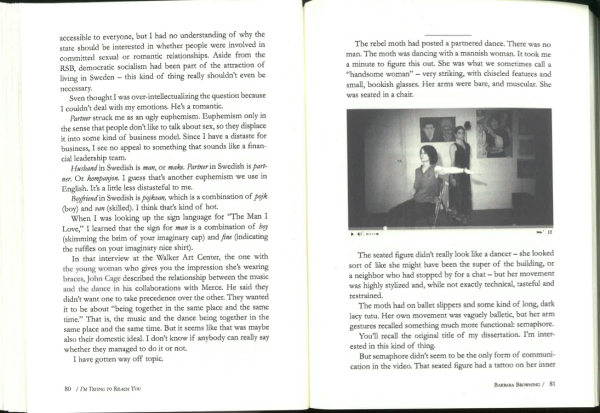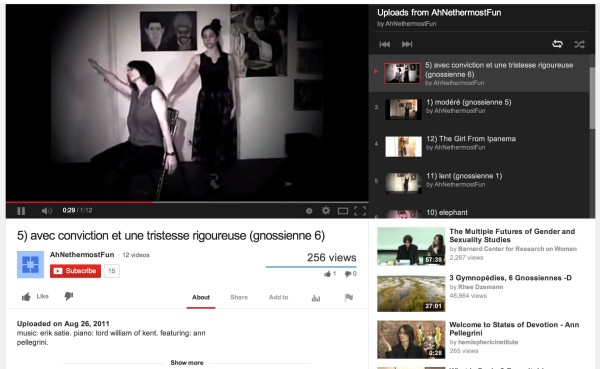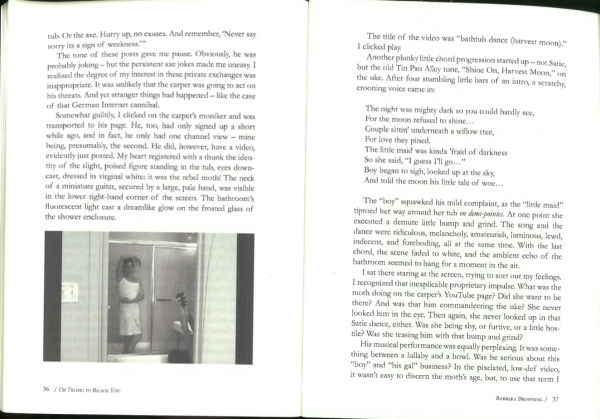Barbara Browning’s I’m Trying to Reach You is an interesting experiment in images, text, and video. It has cell phone pictures in it, but also screen shots from Youtube videos. Some of the screen shots have the progress bar visible (there’s one like that on p. 134), and the narrator sometimes mentions the exact time something happens.
On the dedication page there is a QR code and the note:
All of the moth’s videos can be viewed at: www.youtube.com/AhNethermostFun/.
As the plot unfolds, “the moth’s” videos turn out to be central, and so do the users’ comments on Youtube, some of which are quoted in the book. It is possible to read the book without looking at the videos online, but the reading experience is more interesting if you check Youtube as you read.
The narrative, and the presentation of the book itself, suggest two different relations between the experience of reading and the possibility of viewing the videos. On the one hand there is the QR code at the beginning, and the many passages in which the narrator tells us how many times he’s seen each video. On the other hand, there are descriptions of particular scenes in the videos. Most of the time, those passages keep me focused on the text, because they are presented as self-sufficient descriptions in the manner of traditional ekphrases. Occasionally Browning’s descriptions make me curious about the videos, but I only checked the videos intermittently. Overall the book seems undecided about the role of the videos, and that indecision is not itself a theme in the book.
If you look online, you find that the first of the book’s 12 videos has by far the most views: in April 2014, when I first looked, it had 1,011 views, and in 2019 it had 1,500. The number of views falls quickly for the others; in 2014 most had between 100 and 250. (The low numbers are also a sobering measure of how much the book was read. The views increase incrementally as the years go on, but I assume many people come upon them randomly, or without the book in hand.) I looked at four of the videos while reading the book. Sometimes I experienced the videos like the music video interludes of Hollywood movies—that is, they provided eye relief and an interlude between my readings—and other times they seemed incongruous, because the realities of my own computer (with its other applications, and its different place on my desk) interrupted the fiction Browning was creating. Yet the book itself is partly disjunctive in that way: it is presented as fiction, but it is also very much like her own life. (It’s a familiar kind of life: I know, and know of, several people and places she mentions in the book, including José Muñoz, Nao Bustamante, Lauren Berlant, and NYU, and I’m familiar with themes like dissertations that need to be rewritten, the embarrassments of self-aware deconstructive criticism, and the arts and humanities conference scene.)
Browning makes the veil between her novel and real life even thinner by including a double author’s photograph that has a very strong resemblance to the dancer called “the moth” in the videos. (She also left at least one of her original videos on YouTube with her name on it instead of “the moth.” Why doesn’t she expect that readers will see that she’s “the moth”? It’s not clear if she doesn’t care, hasn’t thought readers would notice, or hasn’t imagined readers who don’t know her.) These coincidences and straightforward realities make the experience of watching the YouTube videos more a part of the book’s purpose, but to be consistent, she could have published everything as an e-book, or also posted the cell phone pictures online, or included more screen shots so readers didn’t feel they need to go online.
Still, the project is memorable because of the narrative impulse: it’s interrupted, fragmented by the hyperlinks and videos, but more powerful than the competing urge to view or read at random.


